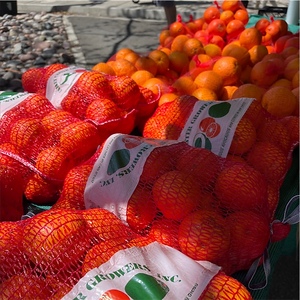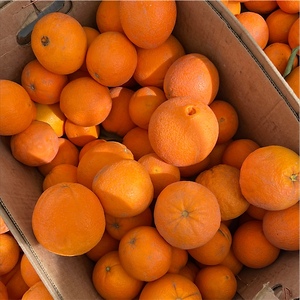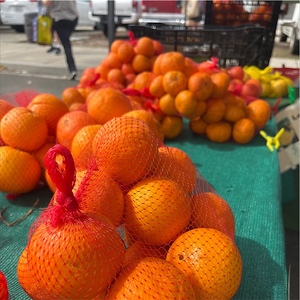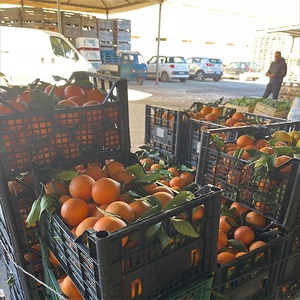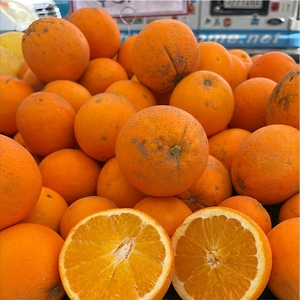

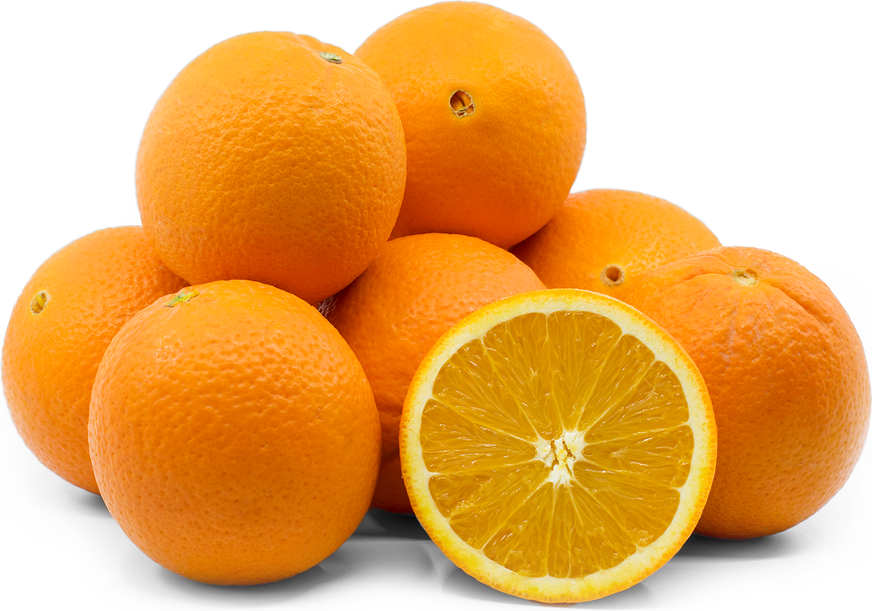
Navel Oranges
Estimated Inventory, 56 ct : 0
Description/Taste
Navel oranges vary in size, depending on growing conditions, and generally average 6 to 10 centimeters in diameter. The fruits have a globular to slightly oval shape with blunt, curved ends. On the blossom stem end, the trademark “navel” appears as a circular hole or small protrusion. The variety’s rind is moderately thick, taut, and firm, enveloped in sunken oil glands, giving the surface a slightly pitted, bumpy feel. The rind ripens from green to saturated dark orange hues and is generally matte and easy to peel. Underneath the surface, the orange flesh is divided into 10 to 12 segments by thin membranes and is aqueous, soft, tender, and succulent. Navel oranges are naturally seedless and release an aromatic, fruity aroma when peeled. The ripe flesh is edible raw and has a mild, sweet, and subtly tangy taste with light fruity and floral nuances.
Seasons/Availability
Navel oranges are available in the winter through spring, with a peak season from November to January.
Current Facts
Navel oranges, botanically classified as Citrus sinensis, are a winter variety belonging to the Rutaceae or citrus family. The sweet cultivar grows on evergreen trees and is commercially produced worldwide as a widespread retail fruit. Navel oranges were discovered growing as a sport on an orange tree in Brazil and acquired their unusual name from a natural mutation found within the fruits. Navel oranges bear a small hole on the blossom end of the fruit, also referred to as a navel, the same term used for human belly buttons. These small holes are created from a secondary fruit that grows inside the orange. This fruit does not fully develop and remains inside the other fruit. Navel oranges are also known as Riverside Navels, Bahia Navels, and Washington Navels. There are many variations and varieties of Navel oranges grown worldwide, and these fruits are generally valued for their sweet taste, seedless nature, and ability to hang well on the trees for an extended growing season.
Nutritional Value
Navel oranges are a source of vitamins A, C, and E to maintain healthy organs, guard cells against free radical damage, and strengthen the immune system. The variety also provides antioxidants to reduce inflammation and support overall bodily health. Beyond vitamins, Navel oranges contain fiber to regulate the digestive tract and minerals, including potassium, magnesium, phosphorus, copper, manganese, zinc, and iron. Potassium balances fluid levels within the body, while magnesium controls daily nerve functions. Phosphorus and manganese help bones and teeth, copper assists the body in producing red blood cells, and iron develops the protein hemoglobin for oxygen transport through the bloodstream.
Applications
Navel oranges have a mild, sweet flavor suited for raw and cooked preparations. The variety is famously consumed out of hand and is savored for its tender flesh and juicy nature. Navel oranges cannot be easily segmented like other varieties due to the second fruit present in the flesh. Cutting the fruit into thin, wheel-like slices is recommended to help retain a manageable shape. Navel oranges can also be sliced and tossed into salads, added to fruit cocktail, or diced into salsa and slaws. Their sweet flavor is sometimes used in ceviche or placed as a topping over parfait. Try blending and freezing Navel oranges to make sorbet, popsicles, or granita. In addition to fresh preparations, Navel oranges are simmered into curds, marmalades, and jellies. They also flavor baked goods such as cakes, cinnamon rolls, and bread. The rind can be zested for flavored salt and sugar or peeled and candied into chewy treats. Savory preparations include roasting the oranges to develop caramelized notes, tossing them into stir-fries, or cooking them into glazes for fish and meats like pork, steak, and poultry. Navel oranges are occasionally pressed into juices. It is important to immediately consume the juice as the variety contains an antioxidant known as limonin, which causes the juice to turn bitter or sour after about thirty minutes of exposure to air. Navel oranges pair well with fruits such as strawberries, bananas, coconut, and pomegranates, fennel, cardamom, jicama, red bell peppers, and nuts like pine, pecans, and pistachios. Whole, unopened Navel oranges will keep for a few days at room temperature and for a few weeks when stored in the refrigerator’s crisper drawer.
Ethnic/Cultural Info
The success of Navel oranges in the United States is centered around trees planted in Riverside, California. The story begins with Eliza Lovell and Luther Tibbets, a couple who resided in Washington, D.C., in the late 1860s. During their time there, Eliza met William Saunders, who worked for the United States Department of Agriculture, and the two remained amicable acquaintances for several years. Some sources claim they may have been neighbors in Washington, D.C. In 1870, the Tibbets family decided to move to the newly established community of Riverside, California, and Eliza wrote to Saunders back in Washington, D.C., requesting citrus cuttings to plant in their yard. Saunders sent the Tibbets family a few cuttings of a newly introduced orange tree in 1873, called Bahia orange and Navel orange at the time, and the family worked with three local horticulturists to plant the trees in their front yard. It is unknown whether the family had two or three trees, but if there was a third one, it may have been killed before detailed records were made. As the trees matured, the local horticulturists who helped the Tibbets with the initial plantings also took cuttings from the trees and grafted them into their own orange trees, sparking a new business for the Tibbets. The family began selling cuttings of their trees, expanding the number of Navel orange trees throughout Southern California. The Tibbets’ trees also bore fruit in 1875 and 1876, earning them recognition for their sweet, seedless fruits. Navel orange trees cannot be grown from seeds due to their seedless nature and are only propagated through cuttings. It is believed that most Navel orange trees found in the United States are descendants of the original cuttings made from the Tibbets’ Navel orange trees. One of the two trees perished in 1922 to root rot after being transplanted to a new location, but the other tree was moved to Arlington Avenue in Riverside to become a California state landmark in 1932. The tree is still alive in the present day and is protected by an iron enclosure with a plaque identifying it as “The most valuable fruit introduction yet made by the United States Department of Agriculture.”
Geography/History
Navel oranges are native to Brazil and were discovered growing as a spontaneous mutation or sport on a tree near Bahia city. The variety is hypothesized to be a natural mutation from a Selecta orange tree, a cultivar introduced to Brazil through Portuguese colonists. Legend has it that a Portuguese colonist planted orange trees in the suburb of Cabulla in Bahia city, and the mutation occurred on one of the trees sometime between 1810 and 1820. The mutated fruit was favored for its sweet taste, seedless nature, and distinct hole on the blossom end, leading it to become a popular variety in Bahia. By 1822, many branches from the new variety were grafted throughout Bahia, and the variety was locally called Laranja de Umbigo or Navel orange. In 1869, a missionary named Francis J.C. Schneider contacted the United States Department of Agriculture, USDA, about the Navel orange trees from Bahia. Schneider wrote a letter about the oranges, which was received by William Saunders, the Superintendent of Garden and Grounds for the USDA. Schneider initially sent a box of twigs to Saunders that perished on the journey, but later, he shipped several seedlings after Saunders’ specific requests for the trees. By 1873, Saunders was successfully growing several orange trees from the seedlings. Twelve cuttings were transported to Florida for evaluations, and later in 1870, a few cuttings were sent to Riverside in Southern California. The seedlings sent to Florida did not survive, but the cuttings thrived in Riverside and began producing fruits in 1875. Navel oranges quickly became a favored cultivar in California and were planted across the state for commercial cultivation. The variety also expanded in production worldwide. In the 1930s, a deadly citrus disease decimated Brazil's original Navel orange trees. The USDA sent budwood from the American-grown Navel orange trees to Brazilian farmers to allow them to re-establish their orchards. Today, Navel oranges are commercially grown worldwide and are also planted in home gardens. When in season, the fruits are widely found through local markets, specialty grocers, and supermarkets.
Recipe Ideas
Recipes that include Navel Oranges. One









